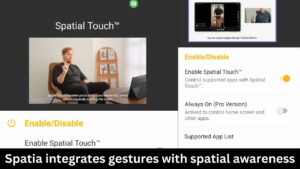Spatia integrates gestures with spatial awareness
A Spatial Touch App integrates touch gestures with spatial awareness, allowing users to interact with digital content in 3D space. This technology is central to augmented reality (AR), virtual reality (VR), and mixed reality (MR), enabling users to manipulate virtual objects as if they exist in the real world. Spatial touch combines spatial computing, which maps physical environments, with touch gestures, such as swipes, pinches, and taps, to create intuitive and immersive user experiences.

Key components of spatial touch technology include spatial awareness, gesture recognition, and real-time feedback. Devices like cameras, LiDAR sensors, and inertial measurement units (IMUs) work together to map the environment and track user gestures. Machine learning algorithms are crucial for recognizing touch gestures and predicting user intent, while edge computing ensures low latency for real-time interactions.
To develop a spatial touch app, the process involves defining the use case, choosing the platform (e.g., Microsoft HoloLens, ARKit/ARCore), building a gesture recognition system, designing the 3D user interface (UI), optimizing for real-time performance, and testing in different environments. Challenges include managing environmental variability, ensuring accurate gesture recognition, real-time processing, and device compatibility.
Spatial touch technology has diverse applications, including gaming, where users can control 3D environments through gestures, education, offering hands-on interaction with virtual models, and healthcare, allowing medical professionals to manipulate 3D models for training and diagnostics. The technology is transforming industries by offering immersive, touch-based control over virtual and augmented environments, making human-computer interaction more intuitive and engaging.
